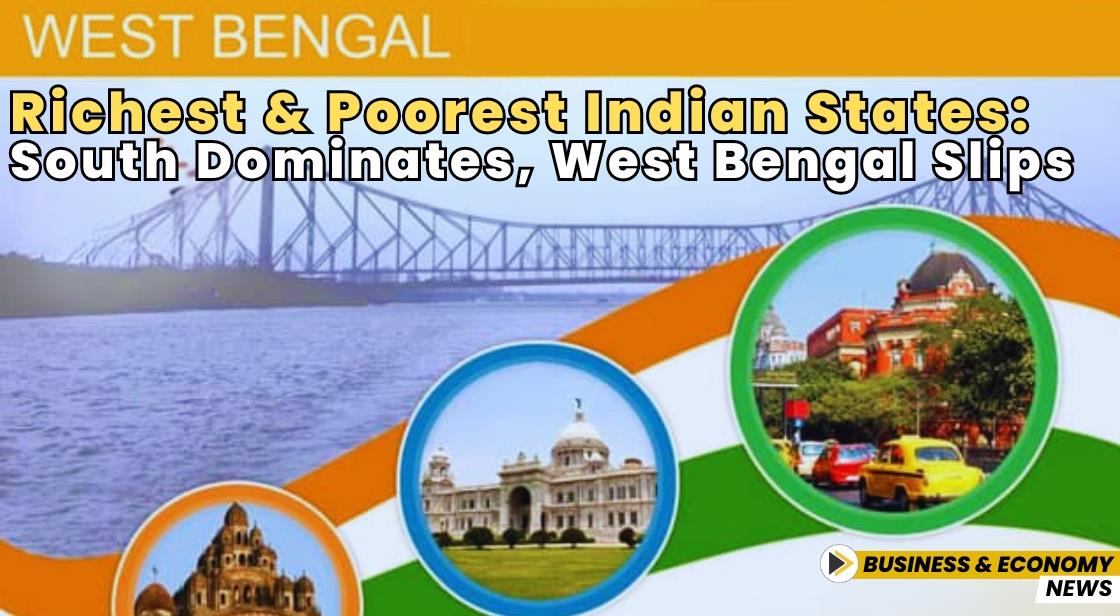Richest and Poorest Indian States: South Dominates, West Bengal Slips

News Synopsis
A recent working paper from the Economic Advisory Council to the Prime Minister (EAC-PM) has exposed major economic disparities between Indian states. The report, released on Tuesday, sheds light on the growing divide between the prosperous southern states and those struggling to keep pace, such as West Bengal, once an economic leader but now facing a decline.
As India's economy continues to evolve, the performance of states has shown remarkable differences. While the southern states—Karnataka, Andhra Pradesh, Telangana, Kerala, and Tamil Nadu—have risen to become key contributors to the national GDP, West Bengal, despite its historical economic strength, is witnessing a concerning downtrend.
Southern States Dominate with 30% Contribution to India’s GDP
The Rise of the Southern Economy
In 1991, the five major southern states had per capita incomes below the national average. However, India's economic liberalisation in the early 1990s acted as a catalyst for growth, propelling these states into a position of economic dominance. By March 2024, these southern states accounted for 30% of India's total GDP.
Karnataka and Tamil Nadu Lead the Charge
Karnataka, with its thriving technology sector, and Tamil Nadu, home to numerous industrial hubs, have been instrumental in this surge. Karnataka, often referred to as the "Silicon Valley of India," has benefited from a booming IT industry. Tamil Nadu's diverse industrial base, including automotive, textiles, and electronics, has also played a pivotal role in driving the region’s economic success.
Telangana, India’s youngest state, formed in 2014, has surprised many with its robust economic performance, further contributing to the southern states' impressive GDP figures.
West Bengal’s Economic Decline: What Went Wrong?
From Prosperity to Decline
Once a major economic force, West Bengal held a substantial 10.5% share of India’s GDP in 1960-61. However, by 2024, this figure had fallen dramatically to just 5.6%. Similarly, the state's per capita income, which once stood at 127.5% of the national average, has now plummeted to 83.7%, placing it behind traditionally lagging states such as Rajasthan and Odisha.
This downward trend is particularly puzzling, as West Bengal enjoys a strategic maritime location and has long been considered a key player in India's economy. The state's underperformance, especially when compared to other maritime regions that have flourished, stands out as a significant economic anomaly.
The Role of Political and Industrial Policies
Experts continue to debate the reasons behind West Bengal's economic stagnation. The report suggests that the state’s industrial policies—and its political climate, which changed dramatically after liberalisation—may have contributed to its fall from economic prominence. Despite its early potential, the state has struggled to adapt to India’s changing economic landscape.
Punjab vs. Haryana: A Tale of Two States
The report also highlights a striking contrast between the fortunes of Punjab and Haryana. Once a leader in economic growth thanks to the Green Revolution, Punjab has seen its growth plateau since 1991. While Punjab's per capita income rose to 169% of the national average by 1971, it has since slipped to 106%.
In contrast, Haryana has witnessed a dramatic rise in per capita income, reaching 176.8% of the national average. Much of this growth has occurred since 2000, placing Haryana well ahead of Punjab in key economic metrics, despite historically lagging behind.
Maharashtra: India’s Largest GDP Contributor Faces Slowdown
Maharashtra's Economic Position
Maharashtra continues to hold its place as India’s largest contributor to GDP, with its financial capital, Mumbai, serving as a critical economic engine. However, its share of the national GDP has fallen from over 15% to 13.3% in recent years.
Maharashtra’s per capita income has risen to 150.7% of the national average by 2024, but it no longer ranks among the top five states in terms of per capita income. The state’s growth, while still significant, has slowed, raising concerns about its long-term trajectory in the face of increasing competition from other states.
Poorest States Struggle to Keep Pace
The report also focuses on India’s poorest states, which have struggled to match the growth of the wealthier regions. Uttar Pradesh, which once contributed 14% of India’s GDP in 1960-61, now accounts for just 9.5%. Similarly, Bihar, despite being the third-most populous state, contributes a mere 4.3% to the national economy.
Odisha's Steady Improvement
Among these poorer states, Odisha has made notable progress, shedding its image as an economic laggard. The state has implemented various reforms that have helped it improve its economic performance, although it still has a long way to go to catch up with more prosperous regions.
Bihar’s Persistent Challenges
In contrast, Bihar remains significantly behind other states in terms of economic development. Despite its large population and abundant natural resources, Bihar continues to face substantial challenges in terms of infrastructure, governance, and investment, limiting its potential for growth.
Regional Economic Disparities Widen
The Economic Advisory Council to the Prime Minister (EAC-PM) report underscores the growing economic divide between India’s states. The southern states, with their proactive embrace of economic reforms, have emerged as national growth drivers, contributing significantly to India's economic expansion. However, the case of West Bengal remains an unresolved puzzle, with the state falling behind despite its early economic promise.
As India continues to grow, addressing these regional disparities will be crucial. The report calls for a deeper investigation into the policies and factors that have shaped state-level economic performance. Understanding the underlying reasons for these economic divides could offer valuable insights into how India can foster more inclusive and balanced growth.
You May Like









